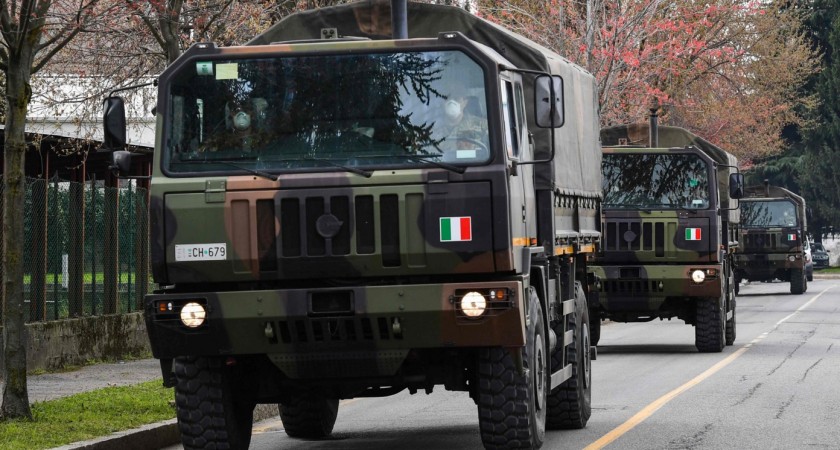The shocking images of the macabre procession of military trucks carrying coffins in the middle of the night from Bergamo to other municipalities in northern Italy went around the world on March 18, 2020. A year later, this city martyred by the coronavirus continues to heal his wounds.
At the height of the pandemic, Father Marco Bergamelli blessed coffins every ten minutes. “It was full of coffins here, there were up to 132 lined up to the foot of the altar,” he recalls, opening the doors of the Monumental Cemetery church wide open.
“At the beginning, the trucks came at night, nobody should have known that the coffins were going elsewhere”. Heavy weights with camouflage tarpaulins removed up to 70 coffins per day from the church, requisitioned because the funeral chambers were full.
At the start of the pandemic, blessed coffins every 10 minutes (photo: AFP).
–
And the cemetery crematorium could no longer follow, in the face of the hecatomb caused by the virus. The coffins were transported to Bologna, Modena or Ferrara to be cremated there.
Come to Bergamo to pay tribute to the 103,000 victims of the pandemic in Italy, Prime Minister Mario Draghi laid a wreath on Thursday at the entrance to the cemetery church, before observing a minute of silence.
“This place is the symbol of the pain of an entire nation”, said Mr. Draghi while attending the unveiling of a “Wood of memory”.
Almost everyone in Bergamo has lost a member of their family, a friend, a colleague or a neighbor.
In the cemetery, sumptuous marble mausoleums adjoin small hastily dug graves, most of them without a tombstone, bearing signs with the names and photos of the deceased: this is the “Campo Covid” B1, reserved for victims of the pandemic.
In March alone, 670 people died in Bergamo, a city of 120,000 inhabitants, and nearly 6,000 in the province of the same name, known as “Wuhan of Italy”, 5 to 6 times more than normal, according to National Institute of Statistics.
“People saw their loved one go by ambulance with a fever, and then they found him reduced to ashes in an urn, without being able to say goodbye to him,” laments Father Bergamelli, 66, moved.
‘Like in times of war’
“It was like in time of war”, says this Capuchin friar with the emaciated face who has gone through funerals but does not consider himself a hero. For him, “the heroes are the doctors and nurses”.
At Seriate hospital, near Bergamo, the intensive care unit is once again full: its eight beds are all occupied by Covid-19 patients, even if the influx is not comparable to the peak of the pandemic a year ago.
Continuous beeps from heart monitors and the purring of artificial ventilators echo through the room.
“The Covid is more aggressive now, with a lot of English variant cases. The patients are younger than before ”, worries Roberto Keim, 59, director of the unit.
Many denounce the slowness of the authorities in recognizing the seriousness of the crisis and in taking restrictive measures, such as banning gatherings.
“At the beginning of March, we saw people attend the funerals of Covid victims and die a few weeks later in their turn,” said Roberta Caprini, manager of the Generali funeral directors.
In the first line
The 38-year-old brunette found herself on the front line of the family business, her father and uncle having been infected.
“Normally we organize 1,400 burials a year, but in March 2020 we did 1,000, almost a year’s work in a month”.
To allow the confined relatives to send a last greeting to the deceased, she would pass the hearse under their balconies and take pictures of the bodies.
Mourning will have been an impossible task for many Bergamasques.
“We spent a month without knowing where the body of my father was, who died of the Covid on March 11 at the age of 85 in a nursing home,” says Luca Fusco, president of the “Noi denunceremo” association (We will denounce).
Three weeks later, his son Stefano created this group to defend Covid victims on Facebook, the next day there were 4,000, and now 70,000.
Then, 250 handrails were filed with the Bergamo prosecutor’s office to “bring justice to all those who have died of the Covid”. An investigation has been opened.
After the appearance of the first cases of coronavirus on February 23, 2020 in the homes of Alzano and Nembro in the Seriana Valley adjacent to Bergamo, highly industrialized, the authorities took 15 days before confining the Lombardy region, precipitating “the pandemic not only in Italy, but throughout Europe, ”says Fusco.
“No one wanted to take an unpopular measure when Lombardy represents 22% of Italy’s gross domestic product”.
The round of 16 first leg of the Atalanta-Valencia Champions League, on February 19 in Milan, will also have played an accelerating role in the epidemic.
For this 59-year-old accountant, “the Bergamasques felt abandoned. By reacting sooner, the authorities could have saved thousands of lives ”.
AFP
–


